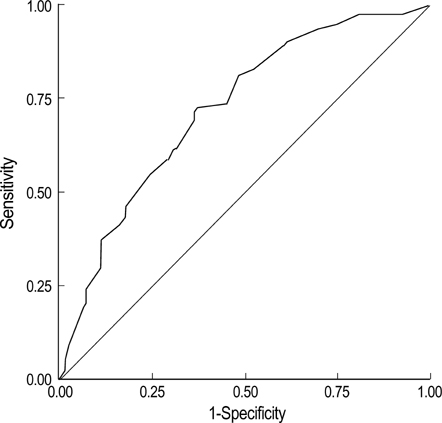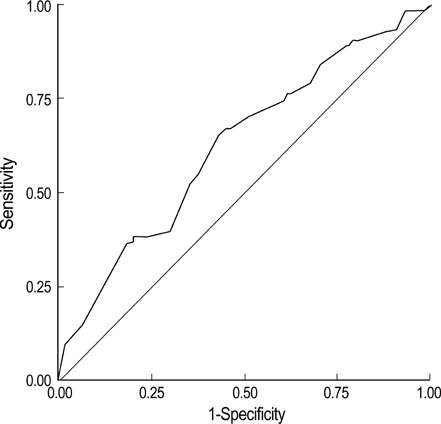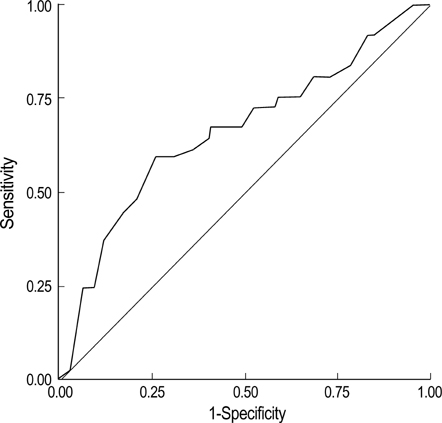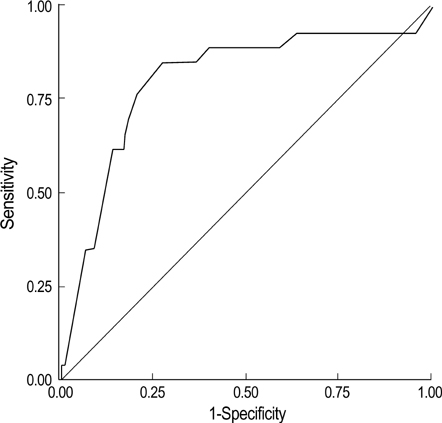J Korean Med Sci.
2005 Apr;20(2):262-266. 10.3346/jkms.2005.20.2.262.
Nomograms for the Prediction of Pathologic Stage of Clinically Localized Prostate Cancer in Korean Men
- Affiliations
-
- 1Department of Urology, Asan Medical Center, University of Ulsan College of Medicine, Seoul, Korea. hjahn@amc.seoul.kr
- 2Department of Pathology, Asan Medical Center, University of Ulsan College of Medicine, Seoul, Korea.
- 3Department of Preventive Medicine, Asan Medical Center, University of Ulsan College of Medicine, Seoul, Korea.
- KMID: 1095201
- DOI: http://doi.org/10.3346/jkms.2005.20.2.262
Abstract
- We analyzed the prostate cancer data of 317 Korean men with clinically localized prostate cancer who underwent radical prostatectomy at Asan Medical Center between June 1990 and November 2003 to construct nomograms predicting the pathologic stage of these tumors, and compared the outcome with preexisting nomograms. Multinomial log-linear regression was performed for the simultaneous prediction of organ-confined disease (OCD), extracapsular extension (ECE), seminal vesicle invasion (SVI) and lymph node metastasis (LNM) using serum prostate-specific antigen (PSA), Gleason score and clinical stage. Nomograms representing percent probabilities were constructed and compared with those presented by Partin et al. by calculating areas under the receiver operating characteristics (ROC) curves. Median serum PSA at surgery was 10.8 ng/mL, and median biopsy Gleason score was 7. Overall OCD, ECE, SVI and LNM rates were 59.6%, 20.5%, 11.7% and 8.2%, respectively, and areas under the curves were 0.724, 0.626, 0.662, and 0.794, respectively. Pathologic stage of localized prostate cancer in Korean men may be predicted using the Partin table, with acceptable accuracy for OCD and LNM, but less so for ECE and SVI.
Keyword
MeSH Terms
Figure
Cited by 2 articles
-
Preoperative Nomograms for Predicting Extracapsular Extension in Korean Men with Localized Prostate Cancer: A Multi-institutional Clinicopathologic Study
Jae Seung Chung, Han Yong Choi, Hae-Ryoung Song, Seok-Soo Byun, Seong il Seo, Cheryn Song, Jin Seon Cho, Sang Eun Lee, Hanjong Ahn, Eun Sik Lee, Won-Jae Kim, Moon Kee Chung, Tae Young Jung, Ho Song Yu, Young Deuk Choi
J Korean Med Sci. 2010;25(10):1443-1448. doi: 10.3346/jkms.2010.25.10.1443.Continuing Trends of the Clinical Parameter Migration in Patients with Prostate Cancer in Korea
Kanghyon Song, Cheryn Song, Hanjong Ahn
Korean J Urol. 2007;48(6):574-578. doi: 10.4111/kju.2007.48.6.574.
Reference
-
1. Partin AW, Kattan MW, Subong EN, Walsh PC, Wojno KJ, Oesterling JE, Scardino PT, Pearson JD. Combination of prostate-specific antigen, clinical stage, and Gleason score to predict pathological stage of localized prostate cancer: a multi-institutional update. JAMA. 1997. 277:1445–1451.
Article2. Partin AW, Yoo J, Carter HB, Pearson JD, Chan DW, Epstein JI, Walsh PC. The use of prostate specific antigen, clinical stage and Gleason score to predict pathological stage in men with localized prostate cancer. J Urol. 1993. 150:110–114.
Article3. Ackerman DA, Barry JM, Wicklund RA, Olson N, Lowe BA. Analysis of risk factors associated with prostate cancer extension to the surgical margin and pelvic node metastasis at radical prostatectomy. J Urol. 1993. 150:1845–1850.
Article4. Egawa S, Suyama K, Arai Y, Matsumoto K, Tsukayama C, Kuwao S, Baba S. A study of pretreatment nomograms to predict pathological stage and biochemical recurrence after radical prostatectomy for clinically resectable prostate cancer in Japanese men. Jpn J Clin Oncol. 2001. 31:74–81.
Article5. Badalament RA, Miller MC, Peller PA, Young DC, Bahn DK, Kochie P, O'Dowd GJ, Veltri RW. An algorithm for predicting nonorgan confined prostate cancer using the results obtained from sextant core biopsies with prostate specific antigen level. J Urol. 1996. 156:1375–1380.
Article6. Rogers E, Gurpinar T, Dillioglugil O, Kattan MW, Goad JR, Scardino PT, Griffith DP. The role of digital rectal examination, biopsy Gleason sum and prostate-specific antigen in selecting patients who require pelvic lymph node dissections for prostate cancer. Br J Urol. 1996. 78:419–425.
Article7. Epstein JI, Walsh PC, Carmichael M, Brendler CB. Pathologic and clinical findings to predict tumor extent of nonpalpable (Stage T1c) prostate cancer. JAMA. 1994. 271:368–374.
Article8. Narayan P, Gajendran V, Taylor SP, Tewari A, Presti JC Jr, Leidich R, Lo R, Palmer K, Shinohara K, Spaulding JT. The role of transrectal ultrasound-guided biopsy-based staging, preoperative serum prostate-specific antigen, and biopsy Gleason score in prediction of final pathologic diagnosis in prostate cancer. Urology. 1995. 46:205–212.
Article9. Egawa S, Suyama K, Matsumoto K, Satoh T, Uchida T, Kuwao S, Koshiba K. Improved predictability of extracapsular extension and seminal vesicle involvement based on clinical and biopsy findings in prostate cancer in Japanese men. Urology. 1998. 52:433–440.
Article10. Blute ML, Bergstralh EJ, Partin AW, Walsh PC, Kattan MW, Scardino PT, Montie JE, Pearson JD, Slezak JM, Zincke H. Validation of Partin tables for predicting pathological stage of clinically localized prostate cancer. J Urol. 2000. 164:1591–1595.
Article11. Kattan MW, Stapleton AM, Wheeler TM, Scardino PT. Evaluation of a nomogram used to predict the pathologic stage of clinically localized prostate carcinoma. Cancer. 1997. 79:528–537.
Article12. Ku JH, Ahn JO, Lee CH, Lee NK, Park YH, Byun SS, Kwak C, Lee SE. Distribution of serum prostate-specific antigen in healthy Korean men: influence of ethnicity. Urology. 2002. 60:475–479.
Article13. Paulson DF. Impact of radical prostatectomy in the management of clinically localized disease. J Urol. 1994. 152:1826–1830.
Article14. Stein A, deKernion JB, Smith RB, Dorey F, Patel H. Prostate specific antigen levels after radical prostatectomy in patients with organ confined and locally extensive prostate cancer. J Urol. 1992. 147:942–946.
Article15. Puppo P, Perachino M. Clinical stage, prostate-specific antigen and Gleason grade to predict extracapsular disease or nodal metastasis in men with newly diagnosed, previously untreated prostate cancer. Eur Urol. 1997. 32:273–279.16. Veltri RW, Miller MC, Mangold LA, O'Dowd GJ, Epstein JI, Partin AW. Prediction of pathological stage in patients with clinical stage T1c prostate cancer: the new challenge. J Urol. 2002. 168:100–104.
Article
- Full Text Links
- Actions
-
Cited
- CITED
-
- Close
- Share
- Similar articles
-
- Nomograms for the Prediction of the Pathological Stage of the Clinically Localized Prostate Cancer in Korean Men
- Clinical Significance of Calculated Prostate Cancer Volume as the Predictor of Pathologic Stage
- Clinico-pathological Characteristics of Prostate Cancer in Korean Men and Nomograms for the Prediction of the Pathological Stage of the Clinically Localized Prostate Cancer: A Multi-institutional Update
- Predictive Value of the Cancer of the Prostate Risk Assessment Score for Recurrence-Free Survival After Radical Prostatectomy in Korea: A Single-Surgeon Series
- Nomogram Using Prostate Health Index for Predicting Prostate Cancer in the Gray Zone: Prospective, Multicenter Study





